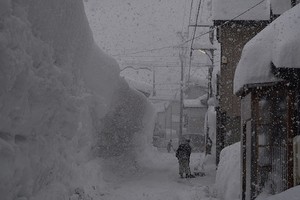THE ASAHI SHIMBUN
January 5, 2024 at 16:18 JST

Hundreds of thousands of social media posts quickly spread fake news that the New Year’s Day earthquake that devastated the Noto region of Ishikawa Prefecture was artificially created, an Asahi Shimbun study found.
Financial greed may be behind the rising trend to share misinformation, even during times of crisis and suffering.
Between 4 p.m. on Jan. 1, when the magnitude-7.6 earthquake struck, and midnight on Jan. 4, about 370,000 messages containing the term “artificial earthquake” were posted on X (formerly Twitter), according to the study using Brandwatch, a social media analytics tool.
The highest number of such posts—about 30,000—were seen between 5 p.m. and 5:59 p.m. on Jan. 1.
One post said, “What do people who say man-made earthquakes are impossible think about this treaty?” It contained a link to a website explaining that an international treaty prohibits the military use of artificially-created earthquakes and tsunami.
The post was viewed an estimated 2.59 million times, leading to more than 1.4 billion hits for the website.
The analysis also showed that “sound of an explosion three times” and “transformer substation” were often written on the “artificial earthquake” posts.
One post stating that “the news of three explosions heard at the Noto transformer substation have been removed all together” was viewed approximately 5 million times.
There were also instances of X users trying to spread their “artificial earthquake” posts by taking advantage of another tragic event. One such post, featuring a video apparently of passengers escaping from the burning Japan Airlines jet at Haneda Airport, was viewed an estimated 6.7 million times.
The study determined the uploading locations of about 150,000 posts containing the phrase “artificial earthquake.” The majority of them originated in Japan, but about 2,000 came from the United States and 750 from Pakistan.
“Conspiracy (theory)” was the most frequently used term in conjunction with “artificial earthquake,” with about 116,000 occurrences.
One post denied the conspiracy theory and stated, “Ridiculous posts such as artificial earthquakes are starting to make the rounds.” It was viewed about 7.89 million times by X users.
Shinichi Yamaguchi, an associate professor at the Center for Global Communications of the International University of Japan, who specializes in disinformation and defamation issues, explained why bogus information and unsubstantiated rumors spread so rapidly.
“Since last summer, X has been allocating revenue based on the number of times a post is viewed, and the ‘attention economy,’ in which attracting attention can bring in income, is spreading at the individual level,” Yamaguchi said.
Yamaguchi said that “Community Notes,” a feature on X that allows users to point out misleading posts by adding legitimate information, “is working better than I thought it would.”
“When you see a post, carefully read it with the Community Notes so you don’t contribute to the spread of misinformation,” he urged.
(This article was written by Azusa Ushio, correspondent, and Azusa Mizuno.)




















A peek through the music industry’s curtain at the producers who harnessed social media to help their idols go global.
A series based on diplomatic documents declassified by Japan’s Foreign Ministry
Here is a collection of first-hand accounts by “hibakusha” atomic bomb survivors.
Cooking experts, chefs and others involved in the field of food introduce their special recipes intertwined with their paths in life.
A series about Japanese-Americans and their memories of World War II